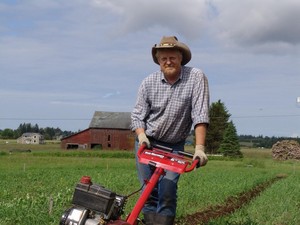03 Mar Wed 2010
The Benefits of Overage for the Consumer/Shareholder
Recently, I responded to a query on the Local Harvest forum about cost comparisons between a CSA share and buying the same produce at a supermarket. Here is my response:
For the 2009 CSA season, my shareholders received an average of $578.13 worth of produce in 20 weeks, while paying an average actual share price of $420.45. This was a bonus (or overage) of 37.5%. For those who paid the full price of $500, this was still a bonus of 15.6%. [I use a multi-tiered pricing system. The earlier you get your money in, the cheaper it is for a share worth $500.]
I do comparison prices with the most popular large supermarket in Ferndale. I use a market-basket approach and compare myself to the LOWEST price in each category (NOT the organic price). On 8/31/09, I was 30.2% above the supermarket retail prices, on average for all the items I sell - 68 categories.
So, doing the math based on August (when the supermarket has their cheapest prices), I provided food in 2009 worth $578.13 that would have been worth $444.03 at the supermarket (578.13 divided by 1.302). This cost the shareholder only $420.45. The net gain for my shareholders was clean, fresh, beyond organic food at a savings of $23.58 over the local popular supermarket chain. A no-brainer.
Notice that my CSA share program provides more food than the shareholder actually purchases. This is called overage. If you buy a share for $500 and you have a 20 week season, you should get $25 worth of food in each week's share box. If you get $28 one week, the extra $3 is called overage. With good recordkeeping, you can see how much each person has accumulated in overage over the season. It is likely that every CSA program has significant overage, since the nature of the CSA model is to pack plenty of food into each weekly box. Remember, most farmers produce more food than they can sell and sustainable farmers are especially prone to do what they do for the social value more than the economic value. Thus, it shouldn't be surprising that overage is a common feature of the CSA model.
Overage is commonly forgotten when comparing prices in the supermarket to prices on the farm or at the farmers market. You don't get a deal at the supermarket when it is almost closing time, or a bag of potatoes when you do a supermarket tour, or "less than perfect" produce at a substantial discount, or a free sample of tetragonia because you live just down the road. Giving away produce is just a fact of life for sustainable farmers and probably most farmers in general (think of those potatoes you gleaned out of the field after the harvesters were done last fall at the big potato farm down the road). What is significant about overage is that it allows the CSA farmer to give the shareholder a better deal with produce he/she might have to compost or give to the food bank anyway. It is also a good way to enourage healthful eating (Eat those peas! We got a ton of 'em right now!) and encourage new taste sensations. (What is tetragonia anyway?).
So when comparing the cost of a CSA program versus picking up your food at a supermarket, think of the overage as well as the freshness, cleanliness of the food and the human value of knowing your farmer. The overage might be the single biggest factor in cost comparisons.

